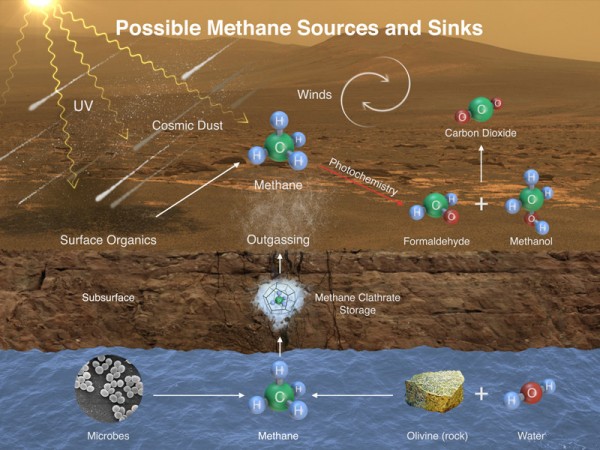Curiosity Rover Finally Detects Organics on Mars
| Ana Verayo | | Dec 17, 2014 03:25 AM EST |
(Photo : NASA/JPL-Caltech/SAM-GSFC/Univ. of Michigan) This illustration portrays possible ways methane might be added to Mars' atmosphere and removed from the atmosphere.
NASA scientists said the Mars Curiosity Rover has detected carbon containing compounds on Mars from samples drilled from an ancient rock. This is the first solid evidence of organic matter on Mars.
The rover also detected some methane gas in the thin Martian atmosphere. Methane is a chemical also found on Earth and linked to the formation of life.
Like Us on Facebook
Although they still don't know when methane gas and organic samples formed on Mars, scientists are finding new ways to unravel these alien geochemical processes.
Curiosity lead scientist John Grotzinger from the California Institute of Technology said the discovery of organics on Mars is a milestone discovery. This brings humankind closer to finding life on the Red Planet.
After landing in August 2012, Curiosity is finally at its prime destination, Mount Sharp inside the Gale Crater. At this 154 kilometer wide impact basin, Curiosity will examine and analyze the chemical composition of rocks that revealed the organics.
According to Curiosity co-investigator Chris Webster from NASA's Jet Propulsion Laboratory, the methane detected was actually a big surprise. Last year, scientists announced that after eight months of searching, they had found no detectable methane on the planet.
Since November 2013, however, the rover continued its search for methane and found a methane spike 10 times larger than others hovering around the rover for a month before it disappeared.
The Curiosity team believes the methane is produced around the rover and dissipated.
Apart from Curiosity, MAVEN and other Earth-bound telescopes also detected visible methane plumes on Mars. Scientists have yet to study the exact sources of the methane bursts.
This study will be published in the journal, Science, this week.
TagsNASA Curiosity Rover Finally Detects Life on Mars Via Methane Gases and Organic Samples, NASA, Curiosity Rover, Mars, methane gas mars, NASA curiosity rover life on mars methane organic, evidence of life on mars
©2015 Chinatopix All rights reserved. Do not reproduce without permission
EDITOR'S PICKS
-

Did the Trump administration just announce plans for a trade war with ‘hostile’ China and Russia?
-

US Senate passes Taiwan travel bill slammed by China
-

As Yan Sihong’s family grieves, here are other Chinese students who went missing abroad. Some have never been found
-

Beijing blasts Western critics who ‘smear China’ with the term sharp power
-

China Envoy Seeks to Defuse Tensions With U.S. as a Trade War Brews
-

Singapore's Deputy PM Provides Bitcoin Vote of Confidence Amid China's Blanket Bans
-

China warns investors over risks in overseas virtual currency trading
-

Chinese government most trustworthy: survey
-

Kashima Antlers On Course For Back-To-Back Titles
MOST POPULAR
LATEST NEWS
Zhou Yongkang: China's Former Security Chief Sentenced to Life in Prison

China's former Chief of the Ministry of Public Security, Zhou Yongkang, has been given a life sentence after he was found guilty of abusing his office, bribery and deliberately ... Full Article
TRENDING STORY

China Pork Prices Expected to Stabilize As The Supplies Recover

Elephone P9000 Smartphone is now on Sale on Amazon India

There's a Big Chance Cliffhangers Won't Still Be Resolved When Grey's Anatomy Season 13 Returns

Supreme Court Ruled on Samsung vs Apple Dispute for Patent Infringement

Microsoft Surface Pro 5 Rumors and Release Date: What is the Latest?










